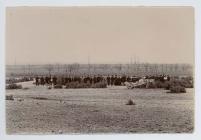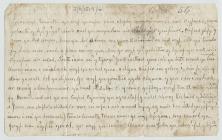Content can be downloaded for non-commercial purposes, such as for personal use or in educational resources.
For commercial purposes please contact the copyright holder directly.
Read more about the The Creative Archive Licence.
Description
Lede
Stories of the Maritime and Commercial Relationships that were forged between Wales and Wicklow.
Story
Chill Mhantáin, County Wicklow, is located on the east coast of Ireland. In 1897 an article released in the Irish Times referred to the active port as the ‘Lake of Ships’. However, in the late 1800s the port came into disrepair. Parliamentary papers during this time announced that there was a lack of funding from the English Government to ports and harbours around Ireland. A report released in 1897 from the House of Commons expressed concern over the decline of Wicklow Harbour as not enough funding was being receiving in order to keep the public works in the local area alive.
Despite the lack of attention given to the maintenance of the port the town continued to develop. Studying the second edition Ordnance Survey map of Wicklow in Geohive, it is possible to identify active sources of employment in the town: a lighthouse, coastguard boathouse, corn mill, saw mill, town market hall, court house, gaol, fever hospital, fair green, lodges, school, Dominican convent, dispensaries, abbey, bank and a military barracks. In 1905 the Irish Times reported that Wicklow port would receive a free grant from the British Government in order to protect the foreshore and the harbour. which were rapidly being cut away due to costal erosion and deposition of silt along the port. A sum of twenty-two thousand pounds was granted to the town in order to repair the damage caused to the port, furthermore, a new north pier was to be built that was five hundred feet in length. The building of the new pier allowed more commercial trade to take place in Wicklow Harbour.
A study of the census in 1911 shows a small number of Welsh-born individuals were located in Co. Wicklow at this time. Shipping returns of 1911 registered many sailors on board ships who were Welsh born - sailors such as Hugh Jones and John Owen who were captain and mate on a small vessel that docked in Bray, Co. Wicklow. The direct commercial route from Dublin Port to Holyhead , Wales brought with it a flow of trade and craftsmanship between Ireland and Britain. For example the Roberts family travelled over from Wales and settled in a house 48 on Main Street, Carnew, Co. Wicklow. The head of the household, Elias Roberts, was a slate maker and his wife, Margaret, was unemployed. Elias and Margaret had six children all under the age of thirteen. William Roberts, who was six years old in 1911, was the last to be born in Wales before they moved to Ireland. The next son Elias Roberts was three years old and he was the first to be born in Wicklow. By identifying the birth dates of the children it can be presumed that the family moved to Ireland between 1905 and 1908.
North Wales is famously known for the quarrying of slate. During the Industrial Revolution the slate industry boomed. Terrace housing meant there was a demand for slate roofing. As well as houses there was also roofing demands for new factories which were erected throughout Britain during the Industrial Revolution. Along with being used as a roofing material, slate was also ground up into a fine powder, which was used to paint ships. Wales produced over four-fifths of slate in Britain during the late 1800s. Similarly, in Kilcavan, Co. Wicklow there was an active slate quarry from the 1800s until the mid 1900s. An article was released in the Irish Times in 1935, which reported a workforce of thirty-three employees in the Kilcavan slate quarry. Elias Roberts would have presumably used the slate that was produced here as it was only twenty kilometres from his home in Carnew, Co.Wicklow.
Marianne Griffiths from Breconshire, Wales was fifty-three years old during the 1911 census. Griffiths served in the household of the retired Colonel Charles George Tottenham in Ballycurry, Co.Wicklow .Griffiths was a cook, and one of nine servants in the household. During this period there was also a British barracks in Shankill which brought many British soldiers across the sea and positioned them in Wicklow and the surrounding counties. A study of Welsh-born inhabitants of Co. Wicklow in the 1911 census reveals employment opportunities and maritime connections between the island of Ireland and Wales.





Do you have information to add to this item? Please leave a comment
Comments (0)
You must be logged in to leave a comment